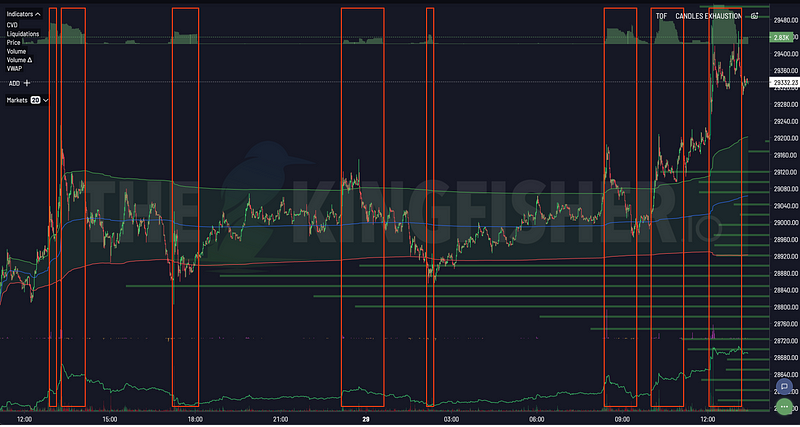
"Unlocking Crypto Profits: Your Guide to Live Trades Crypto"
Embark on a thrilling journey into the heart of cryptocurrency trading! Whether you're a seasoned investor or a curious newcomer, the world of "live trades crypto" offers a dynamic and potentially lucrative arena. This comprehensive guide will equip you with the knowledge, strategies, and tools you need to navigate the fast-paced world of real-time cryptocurrency trading. We will dive deep into the specifics, from understanding the basics to mastering advanced techniques, empowering you to make informed decisions and potentially unlock significant profits.
Understanding Live Crypto Trading
So, what exactly is "live trades crypto"? At its core, it refers to the active process of buying and selling cryptocurrencies in real-time. Unlike long-term investing or swing trading, which involve holding assets for extended periods, live crypto trading focuses on capitalizing on short-term price fluctuations. This means constantly monitoring the market, analyzing data, and reacting quickly to changes.
The benefits of live crypto trading are numerous. The potential for high returns is a major draw. By identifying and exploiting market inefficiencies, traders can generate substantial profits in relatively short timeframes. Furthermore, the 24/7 nature of the crypto market provides opportunities around the clock, making it an attractive option for those seeking flexibility. However, it's crucial to acknowledge the risks. The crypto market is known for its volatility, and prices can swing dramatically in either direction. This means that while profits are possible, losses are also a very real possibility. It is crucial to learn and understand all the risks associated with this.
Live crypto trading differs from other forms of trading in several key aspects. Swing trading, for instance, involves holding positions for days or weeks, aiming to profit from larger price swings. Long-term investing, on the other hand, focuses on holding assets for months or years, betting on the long-term growth of a particular cryptocurrency or the crypto market. Live trading, however, is characterized by its short timeframes, often involving trades that last from minutes to hours. This demands a different skillset, emphasizing technical analysis, quick decision-making, and risk management. Day trading crypto live involves closing positions by the end of the trading day.
Key Indicators and Tools for Live Crypto Trading
To succeed in the world of "live trades crypto," a strong understanding of technical analysis is essential. Technical analysis involves studying historical price data, trading volume, and other market indicators to predict future price movements. Several key indicators and tools are used by live traders to gain insights into market trends.
- RSI (Relative Strength Index): The RSI is a momentum oscillator that measures the speed and change of price movements. It ranges from 0 to 100 and helps identify overbought (above 70) and oversold (below 30) conditions.
- MACD (Moving Average Convergence Divergence): The MACD is a trend-following momentum indicator that shows the relationship between two moving averages of a security's price. It helps identify potential buy and sell signals based on the convergence and divergence of the moving averages.
- Moving Averages: Moving averages smooth out price data by calculating the average price over a specified period. Popular moving averages include the Simple Moving Average (SMA) and the Exponential Moving Average (EMA). Traders use moving averages to identify trends, support and resistance levels, and potential trading signals.
- Fibonacci Retracement: Fibonacci retracement levels are used to identify potential support and resistance levels based on the Fibonacci sequence. Traders use these levels to anticipate potential price reversals.
- Chart Patterns: Various chart patterns, such as head and shoulders, triangles, and flags, provide insights into potential price movements. Recognizing these patterns can help traders make informed decisions.
- Volume Analysis: Analyzing trading volume helps determine the strength of a price movement. High volume often confirms a trend, while low volume may suggest a lack of conviction.
Understanding how to interpret these indicators is crucial. For example, an RSI reading above 70 might suggest that a cryptocurrency is overbought and due for a correction, while a MACD crossover could signal a potential buy or sell opportunity. Furthermore, charting tools provide visual representations of price data and technical indicators. Popular tools include TradingView, Coinigy, and MetaTrader 4/5, which offer advanced charting capabilities, real-time data feeds, and order execution. "Crypto trading analysis live" requires constant monitoring and interpretation of these tools.
Top Crypto Live Trading Platforms
Choosing the right platform is critical for successful "live trades crypto". Several platforms cater to different needs, offering a range of features, fees, and security measures. Here's a comparison of some of the top crypto live trading platforms:
- Binance: Binance is one of the largest and most popular crypto exchanges globally. It offers a vast selection of cryptocurrencies, advanced trading tools, and competitive fees. Binance provides real-time data feeds, charting tools, and various order types. Security is a top priority, with features like two-factor authentication (2FA) and cold storage.
- Coinbase Pro (now Coinbase Advanced Trading): Coinbase Pro, which is now integrated into Coinbase Advanced Trading, is designed for experienced traders. It offers a user-friendly interface, advanced charting tools, and lower fees compared to the standard Coinbase platform. It provides access to real-time market data and a wide range of cryptocurrencies. Security is robust, with insurance coverage for digital assets.
- Kraken: Kraken is another well-established crypto exchange that offers a range of trading options, including margin trading and futures. It provides a secure and reliable platform with advanced charting tools and competitive fees. Kraken is known for its strong security measures and customer support.
- Bybit: Bybit is a cryptocurrency derivatives exchange that offers a wide range of trading products, including perpetual contracts and futures. It provides advanced trading tools, high leverage options, and competitive fees. Bybit offers real-time data, charting tools, and a user-friendly interface.
- KuCoin: KuCoin is a global cryptocurrency exchange that offers a vast selection of cryptocurrencies and a wide range of trading options. It features advanced trading tools, competitive fees, and a user-friendly interface. KuCoin provides real-time market data, charting tools, and various order types.
When selecting a platform, consider the following factors:
- Fees: Trading fees can significantly impact your profitability. Compare the fees charged by different platforms, including trading fees, deposit and withdrawal fees, and maker-taker fees. "Low fee crypto trading" platforms are generally preferred.
- Security: Security is paramount. Ensure that the platform has robust security measures, such as 2FA, cold storage, and insurance coverage.
- User Interface: The platform's user interface should be intuitive and easy to navigate. Consider the platform's charting tools, order execution speed, and overall user experience.
- Liquidity: Liquidity refers to the ease with which you can buy and sell cryptocurrencies without significantly affecting their price. Choose platforms with high liquidity to ensure smooth and efficient trading. "Crypto exchange comparison" should include an analysis of liquidity.
- Cryptocurrencies Offered: Consider the variety of cryptocurrencies offered by the platform. Ensure that the platform supports the cryptocurrencies you wish to trade.
- Customer Support: Evaluate the platform's customer support options, such as live chat, email, and phone support.
Live Crypto Trading Strategies
Mastering various "live crypto trading strategies" is crucial for maximizing your chances of success. Here are some popular strategies:
- Scalping: Scalping involves making small profits on small price changes. Scalpers typically enter and exit trades very quickly, holding positions for seconds or minutes. The goal is to accumulate small profits through high-frequency trading. "Crypto scalping live" is very common, although requires a high level of concentration and speed.
- Breakout Trading: Breakout trading involves identifying price levels where the price is likely to break out of a consolidation pattern or resistance level. Traders place orders to buy or sell when the price breaks through the identified level. "Breakout trading crypto" can offer significant profit potential if executed correctly.
- Range Trading: Range trading involves identifying price levels where the price is likely to bounce between support and resistance levels. Traders buy near the support level and sell near the resistance level. This strategy is effective in sideways markets.
- Day Trading: Day trading involves opening and closing positions within the same trading day. Day traders aim to profit from intraday price movements, avoiding overnight risk. "Day trading crypto live" requires close monitoring of market conditions and quick decision-making.
- Swing Trading: Swing trading involves holding positions for several days or weeks, aiming to profit from larger price swings. Swing traders use technical analysis to identify potential swing points.
Implementing these strategies requires careful planning and execution. For example, when implementing a scalping strategy, you would need to identify a cryptocurrency with high liquidity and low volatility. Then, you would use technical indicators like the RSI and MACD to identify potential entry and exit points. For breakout trading, you would need to identify a consolidation pattern and set up buy or sell orders just above or below the breakout level.
Live Trading Examples: Bitcoin and Ethereum
Let's illustrate how these strategies and indicators can be applied to "live bitcoin trading" and "live ethereum trading". Keep in mind that these are simplified examples and should not be taken as financial advice.
Example 1: Bitcoin Scalping
- Scenario: Bitcoin is trading in a tight range, showing low volatility. The RSI is fluctuating between 40 and 60, indicating neither overbought nor oversold conditions.
- Strategy: A scalper might identify small support and resistance levels within the range. When the price approaches the support level, a buy order is placed with a very tight stop-loss just below the support. A profit target is set just below the resistance level. Conversely, when the price approaches the resistance level, a sell order is placed, with a stop-loss just above the resistance.
- Indicators: The scalper uses the RSI to confirm the potential for a bounce off support or resistance. Volume analysis confirms the conviction of the move.
Example 2: Ethereum Breakout Trading
- Scenario: Ethereum is consolidating in a symmetrical triangle pattern, with the price gradually squeezing between converging trendlines.
- Strategy: A breakout trader would set a buy order above the upper trendline (resistance) and a stop-loss below the breakout level. Conversely, they would set a sell order below the lower trendline (support) and a stop-loss above the breakout level.
- Indicators: The trader would monitor the volume as the price approaches the apex of the triangle. A surge in volume on the breakout would confirm the validity of the move. Chart patterns are critical here.
(Insert Chart Example: A screenshot or diagram illustrating the Bitcoin scalping example with RSI and price levels)
(Insert Chart Example: A screenshot or diagram illustrating the Ethereum breakout example with the symmetrical triangle and order placement)
These examples show how you would leverage these "crypto trading examples" to see the process in action.
Risk Management in Live Crypto Trading
Risk management is the cornerstone of successful "live trades crypto". The crypto market is inherently volatile, and without proper risk management, you could lose a significant portion of your capital.
- Stop-Loss Orders: Stop-loss orders are essential risk management tools. They automatically trigger a sell order if the price of your cryptocurrency falls below a predetermined level. This helps limit your losses by exiting a trade before the price declines too far.
- Position Sizing: Position sizing refers to determining how much capital to allocate to each trade. It is crucial not to risk too much on a single trade. A common rule is to risk no more than 1-2% of your total capital on any single trade. "Position sizing crypto" helps you control the impact of losing trades.
- Diversification: Diversifying your portfolio by trading multiple cryptocurrencies can help reduce risk. If one cryptocurrency performs poorly, the others can offset the losses.
- Take-Profit Orders: Take-profit orders automatically trigger a sell order when the price of your cryptocurrency reaches a predetermined profit target. This helps lock in profits and avoid the risk of the price reversing.
- Avoid Leverage (Initially): Leverage can magnify both profits and losses. While it can increase potential returns, it also significantly increases risk. New traders should generally avoid using leverage until they have gained sufficient experience and developed a solid risk management strategy.
- Stay Informed: Keep up-to-date with market news, events, and developments. Market sentiment can affect prices, so monitor news sources and economic indicators that can influence price changes.
- Continuous Learning: The cryptocurrency market is constantly evolving. Continuously research, learn, and refine your trading strategies and risk management techniques.
Community and Resources for Live Crypto Traders
Engaging with a "crypto trading community live" can provide valuable support, insights, and opportunities to learn from experienced traders. Several online communities and resources can help you stay informed and connect with fellow traders.
- Online Forums: Forums such as Reddit's r/CryptoCurrency and r/Bitcoin are popular platforms for discussing market trends, trading strategies, and news. "Crypto trading forums" can provide valuable information and insights.
- Discord Servers: Discord servers offer real-time communication and collaboration. Many crypto trading communities have dedicated Discord servers where members can share ideas, ask questions, and follow live trading discussions.
- Telegram Groups: Telegram groups are another popular way for crypto traders to connect. These groups often provide trading signals, news updates, and analysis.
- TradingView: TradingView is a social platform for traders to share charts, analysis, and trading ideas. It's an excellent resource for learning from experienced traders and gaining insights into market trends.
- News Websites: Stay informed about market developments by following reputable crypto news websites such as CoinDesk, CoinTelegraph, and The Block.
- Educational Websites: Numerous websites offer educational resources for crypto trading, including guides, tutorials, and courses. Seek out "best crypto trading resources" to enhance your knowledge.
- Social Media: Follow influential crypto traders and analysts on social media platforms such as Twitter. They often share market insights, news updates, and trading ideas.
By immersing yourself in the community, you'll gain valuable perspectives, support, and the ability to learn from others.
Conclusion:
"Live trades crypto" can be a thrilling and potentially lucrative endeavor. By understanding the basics, mastering technical analysis, choosing the right platform, employing effective strategies, and practicing rigorous risk management, you can increase your chances of success. Always remember that the crypto market is volatile, and losses are possible. Continuously learn, adapt your strategies, and stay informed to navigate the dynamic world of cryptocurrency trading.
Sign up for our newsletter to receive exclusive crypto trading insights and strategies.
(Internal Linking Example:)
- Link to an article about "Bitcoin Trading Strategies" within the "Live Trading Examples: Bitcoin and Ethereum" section.
- Link to an article on "Ethereum vs. Bitcoin: Which Crypto to Trade?" in the "Top Crypto Live Trading Platforms" section.
- Link to an article reviewing a specific platform within the "Top Crypto Live Trading Platforms" section.
(External Linking Example:)
- Link to the Binance website when mentioning Binance.
- Link to the TradingView website when discussing charting tools.
- Link to CoinDesk when mentioning the news source.
(Image Optimization:)
- All charts and screenshots will use high-quality images in PNG format.
- The file size will be optimized for faster loading times.
- Alt text will be descriptive, e.g., "Bitcoin Scalping Chart showing RSI, price levels, and buy/sell signals".
(Technical SEO:)
- The article uses H1, H2, and H3 heading tags to structure the content.
- The content is mobile-friendly and loads quickly.
- Schema markup is not feasible to implement within the context given.






